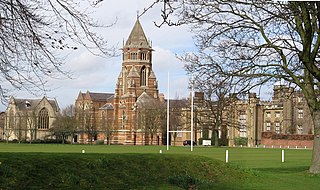
Rugby School is a public school in Rugby, Warwickshire, England.

Wandsworth is a London borough in South West London; it forms part of Inner London and has an estimated population of 329,677 inhabitants. Its main named areas are Battersea, Balham, Putney, Tooting and Wandsworth Town.

Reading School is a state grammar school for boys with academy status in the English town of Reading, the county of Berkshire. It traces its history back to the school of Reading Abbey and is, thus, one of the oldest schools in England, although it closed for a few years in the 1860s. It is a state boarding school. There are no tuition fees for day pupils, and boarders only pay for food and lodging. Reading is one of the best state schools in the UK according to the GCSE and A-level tables and has consistently ranked in the top ten.
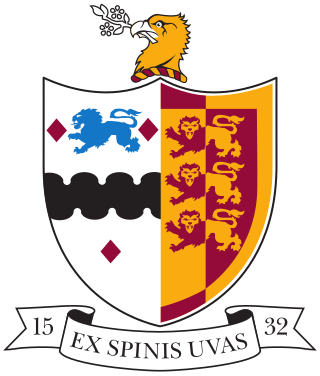
Bristol Grammar School (BGS) is a 4–18 mixed, private day school in Bristol, England. It was founded in 1532 by Royal Charter for the teaching of 'good manners and literature', endowed by wealthy Bristol merchants Robert and Nicholas Thorne. The school flourished in the early 20th century under headmaster Sir Cyril Norwood (1906–1916), embodying "the ideals and experiences of a leading public school". Norwood went on to serve as the master at Marlborough College and Harrow, and as president of St John's College, Oxford.
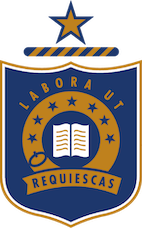
Caulfield Grammar School is a private, co-educational, Anglican, International Baccalaureate, day and boarding school, located in Melbourne, Victoria, Australia. Founded in 1881 as a boys' school, Caulfield Grammar began admitting girls exactly one hundred years later. The school amalgamated with Malvern Memorial Grammar School (MMGS) in 1961, with the MMGS campus becoming Malvern Campus.
Graveney School is a secondary school and sixth form with academy status in the Furzedown area of Tooting, southwest London, England. The school has a partially selective admissions policy. In the beginning of 2015, the school was assessed in an Ofsted inspection report as outstanding.

Lord Wandsworth College (LWC) is a co-educational private school in Long Sutton, Hampshire, England, for day and boarding pupils between the ages of 11–18, which occupies a 1,200 acre campus and is known for its charitable foundation. It is a member of the Headmasters' and Headmistresses' Conference.

Sir Walter St John's was founded in 1700 for twenty boys of the village of Battersea. As the population and the English educational system changed, so did the school. The school was colloquially known as "Sinjuns" and was finally closed in 1986-7.

Borden Grammar School is a grammar school with academy status in Sittingbourne, Kent, England, which educates boys aged 11–18. A small number of girls have also been admitted to the Sixth Form. The school holds specialist status in sports.
Clapham College was a Roman Catholic secondary school for boys in South London.

Enfield Grammar School is a boys' Comprehensive school and sixth form with academy status, founded in 1558, situated in Enfield Town in the London Borough of Enfield in North London.

Streatham & Clapham High School is an independent day school for girls aged 3 to 18, in south London. The school was founded in 1887 by the Girls' Public Day School Company, which established schools for girls providing academic, moral and religious education.
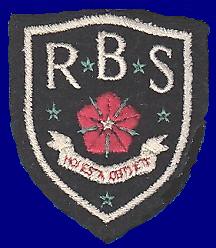
Rosa Bassett School was a grammar school for girls in South London. Established in 1906 in Stockwell as the Stockwell County Secondary School, in 1913 it moved to Welham Road on the boundary between Streatham and Tooting. It was renamed the County Secondary School, Streatham, and was often referred to as Streatham County Secondary School or Streatham Secondary School. It was again renamed in 1951, after the first headmistress, Rosa Bassett.
Furzedown Secondary School was a mixed comprehensive school in South London. It was established in Welham Road on the boundary between Streatham and Tooting in 1977, following the amalgamation of Battersea Grammar boys' school and Rosa Bassett girls' grammar school.
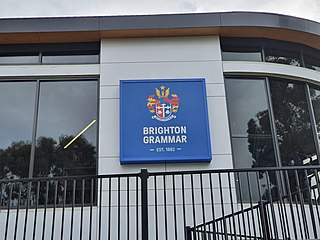
Brighton Grammar School is a private Anglican day school for boys, located in Brighton, a south-eastern suburb of Melbourne, Victoria, Australia.

St Mary's Cemetery is a cemetery opened in 1860 in Wandsworth, London. It was established by St Mary's Burial Board in part of Wandsworth Common. It has also been known as Battersea St Mary's Cemetery and Battersea Rise Cemetery.

John Erskine Clarke (1827–1920) was a British clergyman who issued the first parish magazine. He established several other religious publications and was responsible for founding churches schools and hospitals in Battersea. He also competed at Henley Royal Regatta.

St Dunstan's College is a co-educational private day school in Catford, south-east London, England. It is a registered charity, and a member of the Headmasters' and Headmistresses' Conference and the Independent Association of Prep School Heads. The college is made up of a junior school for 3-10 year olds, a senior school for 11-16 year olds and a sixth form for 16-18 year olds.

Wandsworth School was a local authority maintained boys' secondary school in Southfields, London. Established in 1895, it became a selective grammar school, then an all-ability comprehensive school, before merging in 1986 and finally closing in 1991. From the 1960s it became well known for its choir.
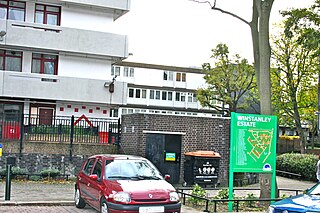
The Winstanley and York Road Estate comprises two large estates of predominantly public housing apartments in Battersea, London, adjacent to Clapham Junction railway station, although some have since passed into private ownership.
















